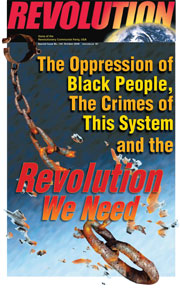From A World to Win News Service:
CoP21: Demonstrations Across Europe and the World
Putting the Negotiators of the Earth's Future on Notice: “The climate is the state of emergency!”
December 7, 2015 | Revolution Newspaper | revcom.us
November 30, 2015. A World to Win News Service. As CoP21 [the international conference on climate change] opened in Paris, climate activists were more determined than ever to demonstrate on November 29, and in many cities came out in very large numbers.
In Europe in particular these protests took place in the shadow of the horrible killings of 130 people in Paris two weeks earlier and the repression the French state unleashed since then. The situation is also marked by international realignments and stepped-up bombing of Syria and the urgent immigrant/refugee crisis that has not waned, but been swept out of the headlines by declarations of war on the Islamic State. Many people evoked both the broad dragnet of police terror against Arabs living in France and the intensifying clash of political forces in the world that have led to other murderous attacks from Ankara to the Sinai to the U.S. bombing of the Kunduz Trauma Centre run by Doctors Without Borders.
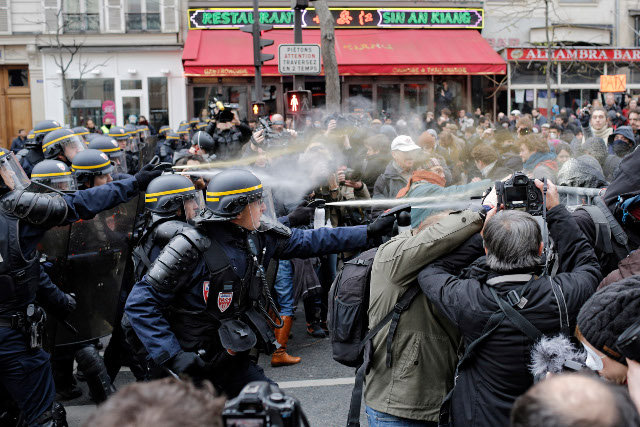 Above: Place de la République, Paris, November 29 (AP photo). Below left: Vancouver, British Columbia (Jimmy Jeong/The Canadian Press via AP). Below right: Athens, Greece (AP photo).
Above: Place de la République, Paris, November 29 (AP photo). Below left: Vancouver, British Columbia (Jimmy Jeong/The Canadian Press via AP). Below right: Athens, Greece (AP photo).
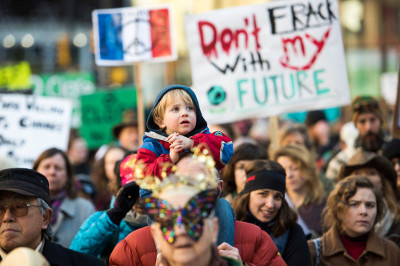
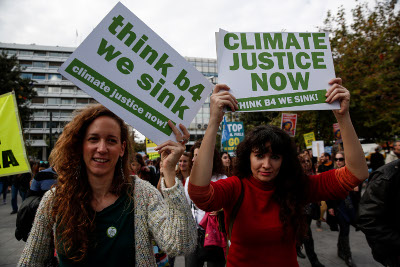
As part of a three-month state of emergency the French authorities banned all outdoor demonstrations, targeting in particular the one on November 29 when hundreds of thousands had been expected to converge in Paris as CoP21 opened, as well as for the "day of action" on December 12 after CoP finished its work. While many people hope that the summit will take measures to reduce CO2 emissions and global warming, many more are very sceptical that this will stop the current disastrous path and so planned big demonstrations in advance.
Some groups active in the mobilisation for a global climate march and affiliated coalitions called for people to travel to and participate in the demonstration in Berlin and other cities instead of going to Paris. In the German capital, a crowd of 17,000 people from many different countries came out in the rain for climate justice. Revolutionaries wore T-shirts with the globe breaking the chains and the message, "Only revolution can save the planet! We have a world to win." They reported that many people grabbed leaflets denouncing the capitalist and imperialist system that is rapidly accelerating the destruction of the planet, a system which the summit negotiators want to preserve and protect at all costs. The leaflet calls on people to think radically and sketches out the ways that a completely different, socialist state would approach changing the economic foundation of capitalism, reversing the damage to the planet and resolving the social ills that people of the world face under capitalism today.
In Madrid, 20,000 marched, as did thousands in Barcelona, Rome, Amsterdam, Athens and other smaller cities.
Despite the lockdown for nearly a week in Brussels that included banning the climate demonstration in the capital, together with the repressive atmosphere connected to the manhunt for people suspected of involvement in the November 13 attacks in Paris, actions took place in five different areas. According to revolutionary activists wearing the same "Only revolution can save the planet" T-shirts as in Berlin, protesters at the central stock exchange raised a range of political views, from “All power to the people” to "Environmental emergency, crisis of democracy." Four thousand people – young, old and children – formed a human chain in the city center. Banner slogans read "The street is ours," "The system must disappear, not the ecosystem," "Paris! We are here for the environment." The Belgian authorities had originally agreed to let demonstrators march in the city of Ostende instead, but that too was not allowed.
Belgian climate activist groups had organised 10,000 people in train, bike and bus caravans to travel to France for November 29 but cancelled in the face of the state of emergency conditions and draconian border controls. French Minister of the Interior Bernard Cazaneuve crowed that CoP21 had been made safer by preventing the entry of 1,000 potential climate demonstrators at France's borders with Germany, Spain, Belgium and Switzerland. Demonstrators in Paris told our reporters that they had in fact witnessed open racial profiling on the public transport networks entering the country.
Defying the State of Emergency in Paris
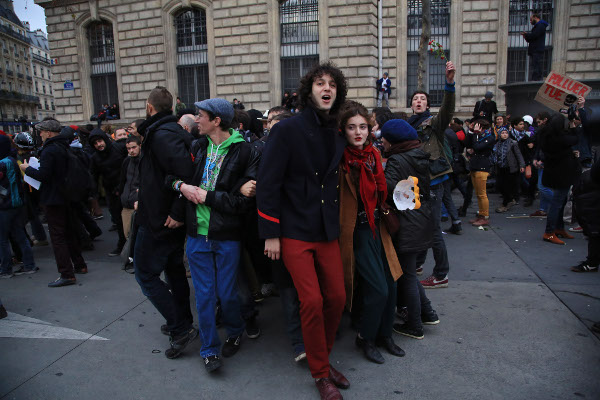
People move into the streets as part of a human chain stretching along the originally intended march route, Paris. (AP photo)
The state of emergency declared in France had, as was intended, a chilling effect on those who felt strongly enough about the climate disaster to go ahead and demonstrate before the CoP21 talks began, according to AWTWNS correspondents who traveled to Paris for the climate activities. While it is likely that some sections of the French ruling class never wanted these massive protests to take place, the state of emergency and security concerns became the vehicle to try to stop them, with the pretext that police could not protect demonstrators and were needed elsewhere. Meanwhile, as activists constantly pointed out, Christmas street markets were not restricted, and outdoor wine festivals and other commercial events went ahead unhindered.
The harsh clampdown under the state of emergency has included 1,200 home raids and hundreds of people being put under house arrest, in most cases without criminal charges. In addition to those the state has called suspected supporters of jihadists – often without evidence – the government also placed 24 environmental activists under house arrest until after CoP21, clearly stating that the reason was to prevent mass mobilisations.
Just as the rulers counted on, climate organisers reacted in different ways to the ban on demonstrations, considered a sacred democratic right, while emotions still run understandably high about the wanton massacres carried out so recently in the streets of Paris – many exactly in the areas where demonstrations are regularly organised. Some climate organisers negotiated symbolic acts with the authorities, agreeing not to demonstrate. These included a display of shoes on the central square at Place de la République, in order to represent all those who wanted to be there but legally could not. They featured shoe contributions from some of the leading representatives of the same system responsible for the climate disaster, such as UN General Secretary Ban Ki Moon, the pope, as well as thousands of others.
Other forces within these coalitions, determined to persist with actions actually bringing people into the streets, organised a human chain stretching along the originally intended November 29 march route. They argued that the massive voice of the people was an important part of the climate summit which could not be successful without it, and called the action part of a "climate of peace." At the last minute, the authorities agreed to this. Some political figures apparently thought that a safety valve was needed for what they knew to be mass frustration and anger over their ban. At the same time, the main news media continued to report only the ban on actions, with a threat of six months in prison for any refusal to comply, and officials told people in Paris to stay home and not use public transport.
Despite the atmosphere of severe intimidation, several thousand people brought with them colorful and highly creative posters, banners, animal masks and home-made body messages for a spirited but static action that lasted about 45 minutes. "There's no planet B," "We're not letting go!" "Stop nuclear [energy]!” Slogans showed a wide variety of political views, not so much diverging on the seriousness of the climate crisis, but the source of it and the solution.
Thousands of other people from many countries assembled directly on the Place de la Republique specifically to defy the state of emergency and demonstration ban. Demonstrators marched around the square, their numbers swelling to between 3,000 and 4,000 as many of those from the human chain poured back to that area to join them.
The police blocked most of the streets leading into the square except one, where people marched, thinking they could break through police lines. In fact the police also blocked that street further down, and tried to encircle the crowd from behind, but were themselves encircled by more demonstrators arriving. One of many chants rang out, "The state of emergency and police state won't stop our right to demonstrate!" "Police everywhere, justice nowhere!"
Watch Bob Avakian: "Not Fit Caretakers of the Earth," a clip from the film Revolution: Why It's Necessary, Why It's Possible, What It's All About, a film of a talk by Bob Avakian given in 2003 in the United States.
People began to march again around the large square. In the mix was a small contingent with a banner "Revolution Nothing Less!" that at one point was hoisted above the crowd from a scaffolding. Some media blame a few dozen anarchists for provoking the CRS (riot police), but the police attacked protesters without distinguishing among them. Pacifist youth sat down in front of CRS lines in one corner of the square and the police sprayed them and others with tear gas, moving in with their batons flaying. Pitched battles between the police and a small number of demonstrators began to engulf the square, while others describe trying to reason with the police to stop and ended up being beaten instead.
As the air filled with tear gas and the police entered the square itself, many demonstrators left, their numbers dwindling to 800 or so, according to reports. The police closed the metro station and isolated a section of demonstrators, hauling away and holding over 300 for questioning, searches and harassment.
The news media has tried to turn this important afternoon of defiance to their state of emergency into an offensive and reactionary political weapon, claiming that the climate activists don't care about paying homage to the victims of November 13 by seizing on a few incidents when candles from the memorial were thrown at the police. This is total nonsense and some protesters came out to defy the ban because they knew people who had been murdered and felt that they had to carry the struggle forward. The Marianne statue at the center of the square had become one of the main memorial sites, decorated with messages or poems in numerous different languages, candles, flowers as well as patriotic gestures promoted by the ruling class such as planting French flags to pay homage to the victims. The demonstrators in fact carefully marched around this memorial, but when fighting broke out and the police entered the square, it was they who recklessly trampled on the tributes, flowers and memorial photos as they pushed demonstrators choking on tear gas out of the way and whacked them with batons. This is captured on many videos taken at the scene but was totally blacked out by the mainstream media.
Artists on the Move
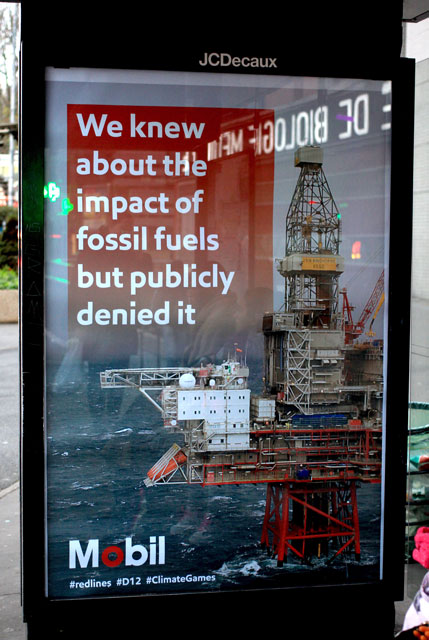
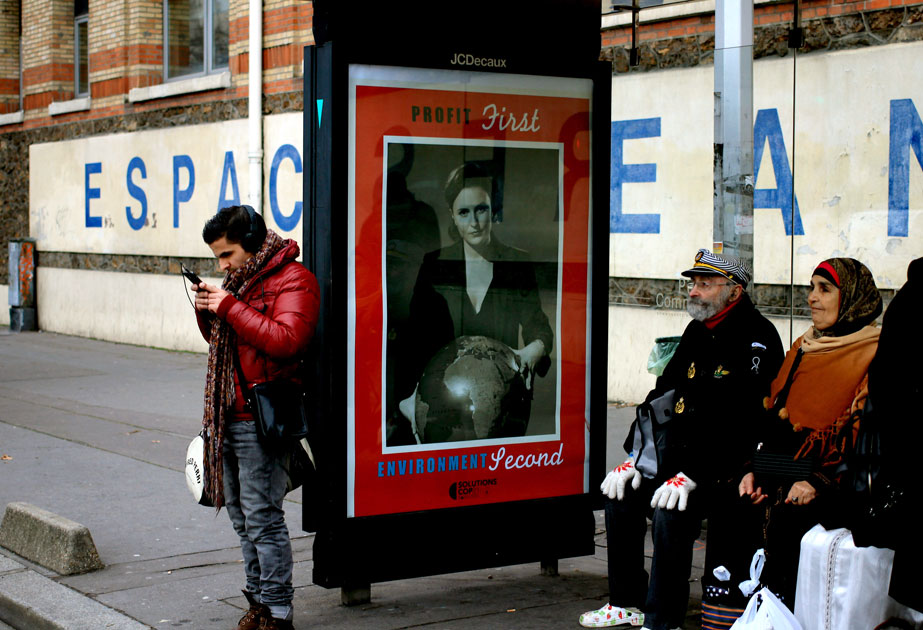 Photos:
brandalism.org.uk
Photos:
brandalism.org.uk
In a different act of defiance, artists practising "brand-alism" replaced the messages blaring out from 600 advertisements across the city to "denounce the multinationals' hold over climate negotiations." They aimed to show "the links between advertising, consumerism, fossil fuel dependency and climate change." Eighty artists from 19 different countries designed artwork that appeared on November 27. They created parodies of CoP21 business sponsors and big polluters such as Air France, Dow Chemical, Engie (former GDF-Suez), and heads of state such as Hollande, Cameron, Obama, Merkel and Abe. They also posted messages such as, in the wake of the tragic events of November 13, the government chose to shut down civil society mobilisations, but big business events proceed unhindered. "Those responsible for climate change continue their 'greenwashing' based on their destructive economic model, but communities directly affected by their activities are reduced to silence." They declared the importance of exposing the lies and going into the streets during CoP21 against fossil fuel energy. (Go to brandalism.org.uk for images and other reports.)
Other Cities Throughout the World
More than 700,000 people worldwide joined in protests on November 29. According to various sources, the largest demonstrations took place in London and Sydney, with 50,000 and 45,000 people, respectively. Representatives from the Pacific island nations of Tonga and Tuvalu joined forces in Sydney to address the already perilous situation for their islands faced with rising sea levels. "Save Tuvalu and the world" said a sign carried from this nation made up of nine tiny islands barely above sea level.
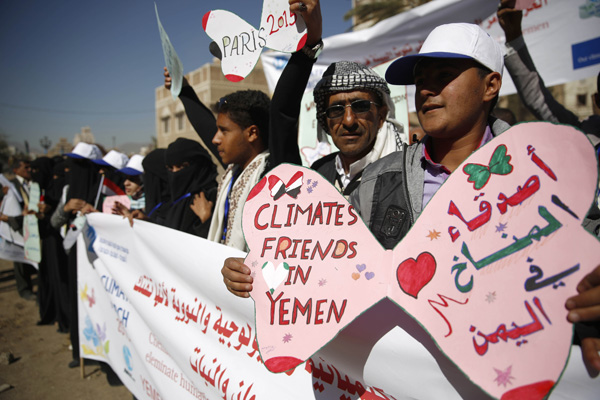
Despite early morning air strikes conducted by U.S.-supplied war planes in the city of Sanaa, Yemen, 70 people joined with the rest of the world in protest against the destruction of the planet. (AP photo)
Thousands also marched in Manila, Philippines, now being devastated by repeated typhoons, a clear sign of the impact of planet-wide climate change. Acutely aware of the high stakes involved for those living in large areas below sea level in their country, people marched in Dhaka, Bangladesh, a country where rising seas and increasingly ferocious storms have already displaced half a million people, with millions more facing the threat of becoming "climate refugees" in the coming decade.
Other demonstrations took place in Ottawa, New York, Los Angeles, Washington, Bogota, Santiago, Rio and Sao Paulo, Johannesburg, Benin, Dar es Salaam, Nairobi, Kathmandu and Tokyo. In Rio de Janeiro, marchers smeared themselves with mud, as a metaphor for the recently burst dam on the river Doce, which spewed toxic waste over huge swaths of farmland, poisoning everything in its path, including drinking water, with toxic effects spreading to the Caribbean. Despite early morning air strikes conducted by U.S.-supplied war planes in the city of Sanaa, Yemen, 70 people joined with the rest of the world in protest against the destruction of the planet.
The march through central London was one of several in cities across the UK that day. It was the largest climate protest London has seen in years. The marchers included people of all ages, particularly teenagers. The mood was more enthusiastic than confrontational, with many groups and individuals taking creative protest initiatives.
To a large extent the tone was set by Labour Party leader Jeremy Corbyn, whose presence should have been discredited by his party's stance regarding Prime Minister David Cameron's proposal that the UK extend its air war from Iraq to Syria. As BBC remarked, although Corbyn "so endeared himself to Labour members because of his opposition to Iraq and other military intervention" in the past (according to a poll, 75 percent of Labour Party supporters are opposed to the UK extending its war participation to Syria), he left his party's parliamentarians free to vote with Cameron. About 5,000 people took part in a London march against more UK military intervention move the day before the climate march, and as many as 10,000 on the eve of the parliamentary vote. Nevertheless, Corbyn was allowed to play a similar role at the climate change march – telling people that parliament and the state represent a solution to the intense concerns they feel about the UK's role in the world and about the world itself. At the end, children put on a play where they satirized the first 20 COP conferences that achieved nothing for the last two decades.
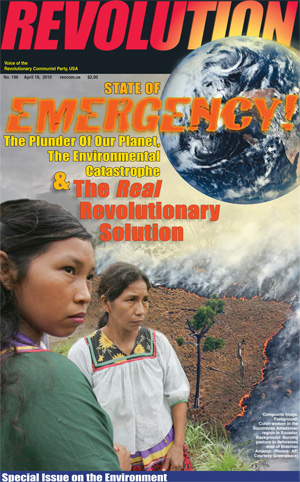
This Revolution special issue focuses on the environmental emergency that now faces humanity and Earth’s ecosystems. In this issue we show:
- the dimensions of the emergency...
- the source of its causes in the capitalist system, and the impossibility of that system solving this crisis...
- a way out and way forward for humanity—a revolutionary society in which we could actually live as custodians of nature, rather than as its plunderers.
Read online....
Also available in brochure format (downloadable PDF)
The global reach of this day of protest in the UK indicates growing awareness and concern about the climate crisis. There was more of a focus on state policy measures on climate change as a political issue than at events in the past, where changing personal habits and reducing personal carbon footprints was often emphasized. Yet the idea that representatives of the governments of the world imperialist system would or could agree to act against their basic, even if contending, interests has been battered by reality again and again, but still holds a strong attraction because most people don't see the system as an interconnected whole.
A popular widespread slogan is "system change, not climate change," representing a very wide range of ideas, including those who want to stop the big polluters within the system, those who think the system could be greened and humanised, and many other variations. Changing the system means changing the whole thing through revolution. These ideas were present in a beginning way in some of these climate demonstrations and much more engagement is needed with what revolution means, why it is necessary and possible and what it would take in the different types of countries.
Volunteers Needed... for revcom.us and Revolution
If you like this article, subscribe, donate to and sustain Revolution newspaper.







